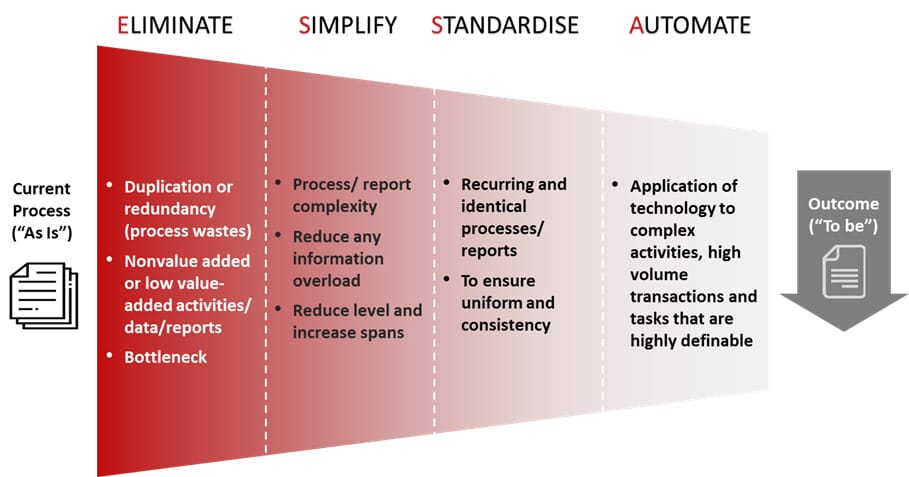Streamlining Efficiency: The ESSA Approach to Eliminate Redundancies and Waste
In today’s fast-paced business environment, efficiency is the key to success. Organizations must constantly strive to eliminate redundancies and reduce waste in their processes to operate at optimal levels. The ESSA (Eliminate, Standardize, Simplify, and Automate) Approach, provides a strategic framework for organizations looking to optimize their operations. In this blog post, we will delve into the core principles of the ESSA approach and explore how it can help organizations achieve higher efficiency.
Understanding the ESSA Approach
The ESSA Approach is built on four fundamental pillars, each contributing to the overarching goal of efficiency:
- 1. Eliminate: The first step in the ESSA approach is to identify and eliminate redundancies and non-value-added processes within an organization. This involves a critical analysis of existing workflows to pinpoint activities that do not contribute to the desired outcomes. By eliminating these inefficiencies, organizations can free up resources and reduce unnecessary costs.
- 2. Standardize: Standardization is about creating uniform processes and procedures across the organization. It ensures that every task is performed consistently, reducing variability and errors. Standardization is particularly valuable when dealing with routine tasks, as it streamlines operations and allows for easier monitoring and improvement.
- 3. Simplify: Simplification is all about making processes more straightforward and less complex. This step involves breaking down intricate workflows into more manageable components. Simplified processes are not only easier to execute but also easier to understand, making it simpler for employees to adhere to best practices.
- 4. Automate: Automation is the final piece of the puzzle in the ESSA Approach. Once redundancies are eliminated, processes are standardized, and workflows simplified, organizations can leverage technology to automate routine tasks. Automation increases efficiency by reducing the need for manual intervention and speeding up processes.

Benefits of the ESSA Approach
Implementing the ESSA Approach can yield numerous benefits for organizations:
– Cost Reduction: By eliminating waste and redundancies, organizations can reduce unnecessary costs and allocate resources more efficiently.
– Enhanced Quality: Standardizing processes and simplifying workflows lead to improved quality and reduced errors.
– Time Savings: Automation of routine tasks frees up employees’ time to focus on more strategic and creative endeavors.
– Increased Productivity: The ESSA Approach allows organizations to accomplish more with the same or fewer resources, boosting overall productivity.
– Competitive Advantage: Streamlining operations positions organizations to be more agile and responsive, giving them a competitive edge in their respective industries.
Case Studies
To illustrate the effectiveness of the ESSA Approach, consider the following case studies:- A. Manufacturing: A manufacturing company implemented the ESSA Approach, leading to a 20% reduction in production time and a 15% decrease in material waste.
- B. Healthcare: A hospital streamlined its administrative processes using ESSA, resulting in shorter patient wait times, reduced paperwork, and improved patient satisfaction.
- C. Finance: A financial institution automated its loan approval process, reducing processing time from weeks to days, and significantly enhancing customer satisfaction.
Conclusion
Efficiency is the cornerstone of success in today’s business landscape. The ESSA Approach, with its focus on eliminating waste, standardizing processes, simplifying workflows, and automating tasks, offers a strategic framework for organizations to achieve optimal efficiency. By implementing the ESSA Approach, businesses can reduce costs, enhance quality, save time, increase productivity, and gain a competitive advantage in their respective markets. Embracing this methodology is a step toward a brighter, more efficient future for any organization.
Learn more: Comprehensive Guide to Impotence Medication: Solutions and Insights

